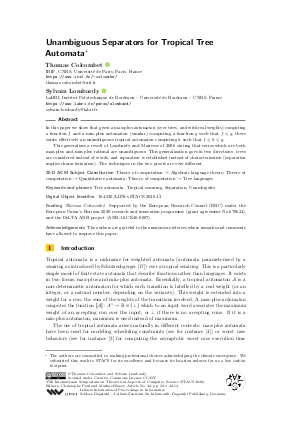Unambiguous Separators for Tropical Tree Automata
Authors
Thomas Colcombet  ,
Sylvain Lombardy
,
Sylvain Lombardy 
-
Part of:
Volume:
37th International Symposium on Theoretical Aspects of Computer Science (STACS 2020)
Part of: Series: Leibniz International Proceedings in Informatics (LIPIcs)
Part of: Conference: Symposium on Theoretical Aspects of Computer Science (STACS) - License:
 Creative Commons Attribution 3.0 Unported license
Creative Commons Attribution 3.0 Unported license
- Publication Date: 2020-03-04
File

PDF
LIPIcs.STACS.2020.32.pdf
- Filesize: 456 kB
- 13 pages
Document Identifiers
Subject Classification
ACM Subject Classification
- Theory of computation → Algebraic language theory
- Theory of computation → Quantitative automata
- Theory of computation → Tree languages
Keywords
- Tree automata
- Tropical semiring
- Separation
- Unambiguity
Metrics
- Access Statistics
-
Total Accesses (updated on a weekly basis)
0Document
0Metadata
Abstract
In this paper we show that given a max-plus automaton (over trees, and with real weights) computing a function f and a min-plus automaton (similar) computing a function g such that f ⩽ g, there exists effectively an unambiguous tropical automaton computing h such that f ⩽ h ⩽ g. This generalizes a result of Lombardy and Mairesse of 2006 stating that series which are both max-plus and min-plus rational are unambiguous. This generalization goes in two directions: trees are considered instead of words, and separation is established instead of characterization (separation implies characterization). The techniques in the two proofs are very different.
Cite As Get BibTex
Thomas Colcombet and Sylvain Lombardy. Unambiguous Separators for Tropical Tree Automata. In 37th International Symposium on Theoretical Aspects of Computer Science (STACS 2020). Leibniz International Proceedings in Informatics (LIPIcs), Volume 154, pp. 32:1-32:13, Schloss Dagstuhl – Leibniz-Zentrum für Informatik (2020)
https://doi.org/10.4230/LIPIcs.STACS.2020.32
BibTex
@InProceedings{colcombet_et_al:LIPIcs.STACS.2020.32,
author = {Colcombet, Thomas and Lombardy, Sylvain},
title = {{Unambiguous Separators for Tropical Tree Automata}},
booktitle = {37th International Symposium on Theoretical Aspects of Computer Science (STACS 2020)},
pages = {32:1--32:13},
series = {Leibniz International Proceedings in Informatics (LIPIcs)},
ISBN = {978-3-95977-140-5},
ISSN = {1868-8969},
year = {2020},
volume = {154},
editor = {Paul, Christophe and Bl\"{a}ser, Markus},
publisher = {Schloss Dagstuhl -- Leibniz-Zentrum f{\"u}r Informatik},
address = {Dagstuhl, Germany},
URL = {https://drops.dagstuhl.de/entities/document/10.4230/LIPIcs.STACS.2020.32},
URN = {urn:nbn:de:0030-drops-118933},
doi = {10.4230/LIPIcs.STACS.2020.32},
annote = {Keywords: Tree automata, Tropical semiring, Separation, Unambiguity}
}
Author Details
Funding
- Colcombet, Thomas: Supported by the European Research Council (ERC) under the European Union’s Horizon 2020 research and innovation programme (grant agreement No.670624), and the DeLTA ANR project (ANR-16-CE40-0007).
Acknowledgements
The authors are grateful to the anonymous referees whose remarks and comments have allowed to improve this paper.
References
- Thomas Colcombet and Laure Daviaud. Approximate comparison of functions computed by distance automata. Theory Comput. Syst., 58(4):579-613, 2016. URL: https://doi.org/10.1007/s00224-015-9643-3.
- Thomas Colcombet, Laure Daviaud, and Florian Zuleger. Size-change abstraction and max-plus automata. In Mathematical Foundations of Computer Science 2014 - 39th International Symposium, MFCS 2014, Budapest, Hungary, August 25-29, 2014. Proceedings, Part I, pages 208-219, 2014. URL: https://doi.org/10.1007/978-3-662-44522-8_18.
- Thomas Colcombet, Laure Daviaud, and Florian Zuleger. Automata and program analysis. In Fundamentals of Computation Theory - 21st International Symposium, FCT 2017, Bordeaux, France, September 11-13, 2017, Proceedings, pages 3-10, 2017. URL: https://doi.org/10.1007/978-3-662-55751-8_1.
-
Stéphane Gaubert and Jean Mairesse. Idempotency. In Jeremy Gunawardena, editor, Idempotency, volume 11 of Publications of the Newton Institute, chapter Task resource models and (max,+) automata, pages 133-144. Cambridge University Press, 1998.

- Kosaburo Hashiguchi. Limitedness theorem on finite automata with distance functions. J. Comput. Syst. Sci., 24(2):233-244, 1982. URL: https://doi.org/10.1016/0022-0000(82)90051-4.
- Kosaburo Hashiguchi. Algorithms for determining relative star height and star height. Inf. Comput., 78(2):124-169, 1988. URL: https://doi.org/10.1016/0890-5401(88)90033-8.
- Daniel Kirsten and Sylvain Lombardy. Deciding unambiguity and sequentiality of polynomially ambiguous min-plus automata. In 26th International Symposium on Theoretical Aspects of Computer Science, STACS 2009, pages 589-600, 2009. URL: https://doi.org/10.4230/LIPIcs.STACS.2009.1850.
- Ines Klimann, Sylvain Lombardy, Jean Mairesse, and Christophe Prieur. Deciding unambiguity and sequentiality from a finitely ambiguous max-plus automaton. Theor. Comput. Sci., 327(3):349-373, 2004. URL: https://doi.org/10.1016/j.tcs.2004.02.049.
- Daniel Krob. The equality problem for rational series with multiplicities in the tropical semiring is undecidable. IJAC, 4(3):405-426, 1994. URL: https://doi.org/10.1142/S0218196794000063.
- Denis Kuperberg and Michael Vanden Boom. Quasi-weak cost automata: A new variant of weakness. In IARCS Annual Conference on Foundations of Software Technology and Theoretical Computer Science, FSTTCS 2011, pages 66-77, 2011. URL: https://doi.org/10.4230/LIPIcs.FSTTCS.2011.66.
- Denis Kuperberg and Michael Vanden Boom. On the expressive power of cost logics over infinite words. In Automata, Languages, and Programming - 39th International Colloquium, ICALP 2012, Warwick, UK, July 9-13, 2012, Proceedings, Part II, pages 287-298, 2012. URL: https://doi.org/10.1007/978-3-642-31585-5_28.
- Hing Leung. Limitedness theorem on finite automata with distance functions: An algebraic proof. Theor. Comput. Sci., 81(1):137-145, 1991. URL: https://doi.org/10.1016/0304-3975(91)90321-R.
- Sylvain Lombardy and Jean Mairesse. Series which are both max-plus and min-plus rational are unambiguous. ITA, 40(1):1-14, 2006. URL: https://doi.org/10.1051/ita:2005042.
- Sylvain Lombardy and Jean Mairesse. Series which are both max-plus and min-plus rational are unambiguous. arXiv e-prints, page arXiv:0709.3257, September 2007. URL: http://arxiv.org/abs/0709.3257.
-
Michael O. Rabin. Weakly definable relations and special automata. Mathematical Logic and Foundations of Set Theory, pages 1-23, 1970.

-
Antonio Restivo and Christophe Reutenauer. On cancellation properties of languages which are support of rational series. Journal of Computer System Sciences, 29:153-159, 1984.

- Marcel Paul Schützenberger. On the definition of a family of automata. Information and Control, 4(2-3):245-270, 1961. URL: https://doi.org/10.1016/S0019-9958(61)80020-X.
- Michał Skrzypczak. Separation property for wb- and ws-regular languages. Logical Methods in Computer Science, 10(1), 2014. URL: https://doi.org/10.2168/LMCS-10(1:8)2014.
- Denis Thérien and Thomas Wilke. Nesting until and since in linear temporal logic. Theory Comput. Syst., 37(1):111-131, 2004. URL: https://doi.org/10.1007/s00224-003-1109-3.
